|
When Pete Dye Speaks,
People Listen.
Pete
Dye is normally a man of few words. But he gave an excellent
acceptance speech at the 2008 World Golf Hall of Fame Induction
Ceremony on 11/10/08. The world-renown ASGCA Golf Course Architect
spoke to the audience filled with golf celebrities and industry
dignitaries like he would to a group of old friends, which many
of them were.
He
graciously thanked several of the people that he had worked with
during his long illustrious career, but mostly he kept it upbeat
and entertaining, as he told jokes while cronologically detailing
many of the highlights of his life.
Dye
was introduced onto the stage at the induction ceremony by his
long time friend and fellow World Golf Hall of Fame member, Greg
Norman, whose words are transcribed here, verbatim.
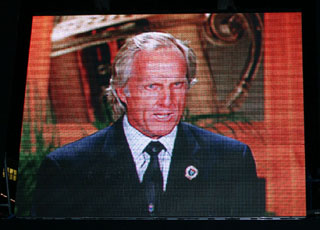 Greg Norman as viewed on one of two
giant screens while introducing inductee, Pete Dye at the 2008
World Golf Hall of Fame Induction Ceremony on 11/10/08. Greg Norman as viewed on one of two
giant screens while introducing inductee, Pete Dye at the 2008
World Golf Hall of Fame Induction Ceremony on 11/10/08.
GREG NORMAN: Ladies and gentlemen, before we get
into talking about Pete, I need to talk about a young lady who's
sitting down here in the audience, and that young lady's name
is Alice Dye. Last week I was in a meeting on Thursday at about
10:00 o'clock in the morning, and my secretary kept coming in
to me and saying, there's a lady on the phone who would like
to speak to you. I said, take a message and I'll call her back.
About 40 minutes later my secretary comes back into the meeting
and said, excuse me, this lady is still on the phone and she'd
like to speak to you now. I said, who is that? She said, it's
Alice Dye. I said, tell her I'll call her back in a few minutes.
About
40 minutes later I go back and I call up Alice. Alice said, "Greg,
we'd like you to come and introduce Pete for his induction into
the Hall of Fame," and she said, "You're our No. 2
choice." I said, "Boy, Alice, you really know how to
make me feel good." So she explained about Deane Beman,
and Deane I know unfortunately couldn't be here tonight, and
we wish you all the best for your recovery from your surgery.
But Alice was there in her wonderful style and her directness
and very poignant approach towards "get your ass here".
And this is what I love about Alice and Pete Dye. They've been
a team beyond all teams, and if the World Golf Hall of Fame could
induct two people at the same time, Alice should be up here with
Pete at the same time. But that's no slight on Pete.
We
all know Pete Dye. For some of us have played his golf courses
and some of us haven't played his golf courses, he's been a player
who's really tested us. He's been a designer who's really tested
us even more. For those of you who have played with Pete Dye,
I don't know how he can be such a brilliant architect because
he is the worst golfer God ever put on this planet! All he does
is hit low, flat, snap-hooks, and for him to build these golf
courses with such small greens, such penal bunkers is beyond
my imagination, but it's a true testament to the individual that
he really is.
I
got my love for golf course design from Pete, and I got my love
for golf course design by the attitude and the approach he took
me down. He told me, “Greg, you know what, everybody looks
at the green grass, they look at how fast the greens are, how
good the tees are, put a flag on the green, put the tee markers
on the tee and then go play. They never really look at what happens
underneath that grass.”
Pete
taught me an invaluable lesson about sub-surface structure of
golf course construction, and Pete is a genius. Pete is a genius
with the environment, he's a genius the way he protects the environment,
and he's a genius the way he creates the irrigation and creates
drainage. And beyond all that, Pete has the wisdom to be able
to picture golf shots in his mind that are going to test the
best players in the world.
And
in 1993, I was down there collaborating with Pete at the Medalist
Golf Club, and just before I left the Medalist Golf Club, I said,
I think I'm going to go up there to Jacksonville to the TPC Sawgrass.
I said, I'm going to shoot an extremely low number up there;
I can't remember whether I said 24-under. He looked at me and
said, "Hah, sure you will." I couldn't wait to get
back to Pete. I said, "Okay, Pete, is that all you've got?"
But
at the end of the day, our relationship has gone on and on and
on, and it's an honor for me to be standing up here to introduce
Pete. He's a spritely, as he puts it, half of 166. He's been
around the game of golf longer than many of us down here have
played, and as I said, and I read in a book one time where Pete
said, "Golfers love to be punished," and how true is
that? How many of us out here really love to play the game of
golf but get very bored when you're playing a very boring golf
course?
Pete
has the ability to make you remember every shot you've played
for the 18 holes you've played that day, and that's a very, very
rare talent indeed. He designs golf courses that challenge the
best players in the world. He designs golf courses that everybody
loves to play. And I don't know what's going to happen over here
in Pete Dye's locker up there in the World Golf Hall of Fame
because I don't know whether they're going to put fescue, bahia,
bentgrass, cooch, railway ties or maybe even the pothole bunkers
at the 14th hole at Harbour Town, which is one of my favorite
golf courses and the first Pete Dye golf course I ever played.
Before
I bring Pete out here, I want to read off the awards and accolades
that Pete Dye has got. This will be Pete's 12th award. Pete has
got the Donald Ross Award from the American Society of golf course
architects; the Old Tom Morris Award from the Golf Course Superintendents
Association of America; the Golf World Magazine Architect of
the Year Award; the Sagamore Wabash, from the State of Indiana;
the Red Coat Award from the Anthonys of Fort Wayne; Ohio Hall
of Fame; Indiana Hall of Fame; Family of the Year Award from
the NGF; Indiana Pathfinder Award; Doctor of Landscape Architecture
from the Purdue University; and honorary member of the Indiana
PGA.
Pete,
welcome to the World Golf Hall of Fame. You are truly an inspiration
to me. You've been an inspiration as a professional and also
as a friend, and Pete, welcome. (Applause.)
After
Greg Norman introduced his good friend, world-renown ASGCA Golf
Course Architect, Pete Dye, the audience at the 2008 World Golf
Hall of Fame Induction Ceremony gave Dye a standing ovation as
he walked on-stage and up to the to the podium. Norman then took
a seat in the audience next to Pete’s wife, world-renown
ASGCA Golf Course Architect, Alice Dye. When the applause finally
died down Pete Dye, the newly inducted Hall of Fame member, began
his very humorous and down-to-earth acceptance speech as thusly
transcribed here verbatim.
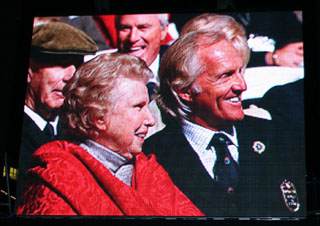 Greg Norman and Alice Dye as viewed
on one of two giant screens while Pete Dye spoke at the 2008
World Golf Hall of Fame Induction Ceremony on 11/10/08. Greg Norman and Alice Dye as viewed
on one of two giant screens while Pete Dye spoke at the 2008
World Golf Hall of Fame Induction Ceremony on 11/10/08.
PETE DYE: Greg said enough about me, and it's
cold enough, maybe we should all just go home (audience laughter).
But
really, I surely wouldn't be here if it wasn't for my mom and
dad, so I've got to thank them. They're the ones that got me
here, some way or another. I don't know what they did, but something
happened.
You
know, two of our posthumous inductees tonight, Denny Shute and
Herbert Wind, I'm one of the few that’s been around long
enough to have known them both. Denny Shute used to make exhibitions
during World War II, and when I was a kid we used to go watch
him play. He was really great.
And
then when I was working in the Dominican Republic, Herbert Warren
Wind showed up down there to do an article in Golf Digest, and
boy, was I elated. This man was pretty well known and was going
to write about me. I thought it was wonderful.
So
he was down there and he asked me all these different questions
and went around and around and around, and finally he left, and
in about the second sentence of his article he said, "Pete
Dye is totally illiterate in two languages, Spanish and English."
(Pete's Speech continued below)
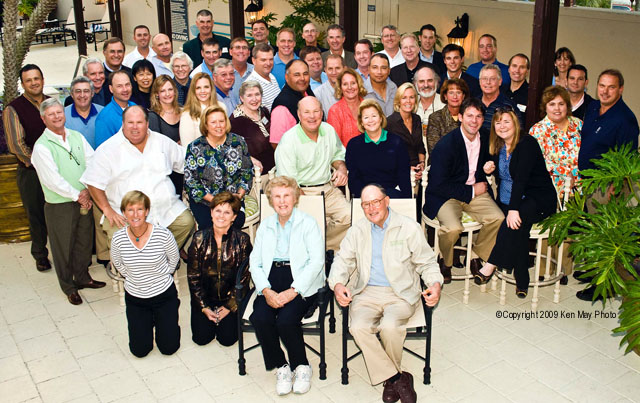
Friends and Associates at Pete Dye’s Hall Of Fame Reception
11/9/08
Last
night was really a great night. There were 67 young men that
have been pushing dirt with me for the last few years that came
in to St. Augustine and had a little reception for me. Some of
them came all the way from Greece, another one all the way from
Seattle. So they're great people, and they're the guys that have
really pushed me to this point. (Pete's Speech continued below)
1. Pete Dye - GOLF HALL OF FAMER
2. Alice Dye - PETE’S SPOUCE - ASGCA PAST PRESIDENT
3. Jean Schmidt - ASGCA SPOUCE
4. Jean’s Friend - JENNIFER MACCURRACH
5. Lucy Dye Brown - PETE’S GRANDDAUGHTER
6. Erik Bowman - JUNIOR DESIGNER DYE DESIGN
7. Ann Dye - PERRY’S SPOUCE
8. Perry O. Dye - PETE’S SON - ASGCA MEMBER
9. Jean Dye - P.B. DYE’S SPOUCE
10. P.B. De - PETE’S SON – ASGCA MEMBER
11. Cary Corbit - GM. HARBOUR TOWN SEA PINES PLANTATION
12. Carlos Perez - JOSE MIRON’S SON
13. “Chepe” Jose Miron - GOLF COURSE DEVELOPER
14. Bill Coore - ASGCA MEMBER
15. Lee Scmidt - ASGCA MEMBER
16. Jim Scott - GOLF COURSE SUPERINTENDENT
17. Abe Wilson - GOLF COURSE BUILDER & DESIGNER
18. Lu Shaw - AUTHOR’S SPOUCE
19. Laurie Thompson - PETE & ALICE’S EXC. ASSISTANT
20. Brian Curley - ASGCA MEMBER
21. Mark Shaw - AUTHOR OF “BURY ME IN A POT BUNKER”
22. Chris Lutzke - GOLF COURSE BUILDER & ARCHITECT
23. Jeff Tourangeau - MACCURRACH GOLF BUILDER ASSOCIATE
24. Shannon Meeks - PETE & ALICE’S EXC. ASSISTANT
25. Gary Grandstaff - SUPERINTENDENT - PETE DYE CLUB
26. Brian Alimony - MACCURRACH GOLF BUILDER ASSOCIATE
27. Shirley Grandstaff - Gary GrandRANDSTAFF’S SPOUCE
28. Scott Poole - GOLF COURSE BUILDER & ARCHITECT
29. Butch Laporte - GOLF COURSE BUILDER & DESIGNER
30. Mike Lee - DIRECTOR OF GOLF - KOHLER
31. Jim Urbina - GOLF COURSE BUILDER & DESIGNER
32. Keith Sparkman - GOLF COURSE BUILDER & DESIGNER
33. Chris Kleinsmith - MACCURRACH GOLF BUILDER ASSOCIATE
34. Bobby Weed - ASGCA MEMBER
35. Joe Darsch - DIANE DARSCH’S SPOUCE |
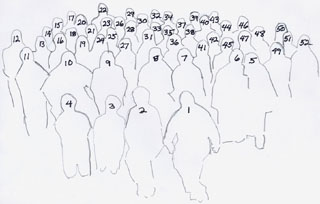
36. Diane Darsch - PETE & ALICE’S
EXC. ASSISTANT
37. Bob Patton - DIRECTOR OF GOLF – LONG COVE CLUB
38. Derick Anderson - PETE’S LONG TIME FRIEND
39. Allan Maccurrach - MACCURRACH GOLF OWNER & BUILDER
40. Timothy Liddy - ASGCA MEMBER
41. Leslie Weed - BOBBY WEED’S SPOUCE
42. David Postlewaite - GOLF COURSE BUILDER & DESIGNER
43. Chris Monti - BOBBY WEED ASSOCIATE DESSIGNER
44. Nelson Caron - FORD PLANTATION
45. TIM’S SPOUSE
46. Dave Swift - SUPERINTENDENT - WHISTLING STRAIGHTS
47. Rod Witman - GOLF COURSE BUILDER & DESIGNER
48. Steve Friedlander - DIRECTOR OF GOLF – PELICAN HILL
49. Ann Langkau - MIKE LANGAU’S SPOUCE
50. Christ Sherman - ASGCA SPOUCE
51. Scot Sherman - ASGCA MEMBER
52. Mike Langkau - GOLF COURSE BUILDER |
And
also I want to thank my bride. She's been with me 58, almost
59 years now, so we’re hanging pretty good, and our two
boys, P.B. and Perry Dye, are both members of the American Society
of Architects. They've been digging up other people's property
just like me.
But
we've had a great time. And Greg, I still don't know how you
ever shot 24-under up here, and I never will get over it (laughter).
But I really have come back to the TPC five times now to rebuild
it, and maybe if I hang around a little longer Mr. Finchem will
let me do it one more time and I might get it right the next
time. It's been really fun.
And
my dad, I have to get back to him. In 1923, he had never played
golf, and one time his car broke down while going through Farmington,
Pennsylvania, and he had to stop there and there was a little
nine-hole golf course there at the Summit Hotel, and he had to
wait on his car to be fixed, so he hit these golf balls and he
got hooked on golf.
He
didn't have much experience, but the following year he went back
to our little town of Urbana, Ohio, and I’ll always remember
hearing my dad say “I'm from Urbana, Ohio,” and he
built a little nine-hole golf course on some land that my mother's
family owned, and my son P.B. came back 70 years later in1993
and built the second nine-hole at the Urbana Country Club. Urbana
is a very conservative little town. We don't move too fast there.
But
my dad, he had a group of members in this little private club
and it was doing quite well. When I arrived in the world, I first
remember just going out there with him. He gave me a job, and
I got a hose and I watered the greens with just a garden hose.
So I stayed there and I worked on that golf course every summer
until the start of the war.
And
at that time the superintendent or greenskeeper got drafted,
and so at 16 I'm now the greenskeeper of Urbana Country Club,
and I surely know everything about it. Somehow or another, I
was able to kill all the greens. (laughter) My father wasn't
too pleased about that, so he shipped me off to the Army in 1944.
I
ended up in the parachute infantry. I want to tell everybody
how I won the war, but really all I did was jump out over Georgia
and North Carolina, and somehow or another, when we got to North
Carolina, I ended up at Fort Bragg, and Mr. Truman did a little
something to stop the war, and I had six months left to stay
in.
So
they didn't want to jump anymore, so I'm now the greenskeeper
at the Fort Bragg golf course. I didn't really have any trouble
there because they had sand greens, and I couldn't kill them
(laughter). So I had a great time, went over to see Pinehurst
every day and played the golf course at Pinehurst No. 2 for six
solid months, and I got to know Mr. Donald Ross.
He
had built the Fort Bragg golf course, and he said, “don't
do much damage to those greens over there,” and I said,
“no, we'll hang in there.” But I got to know him quite
well, and he would come over and watch us play golf, and most
of the time the captain and colonel hauled me over there. They
didn't know who Mr. Ross was, but the other fellow walking with
him was JC Penney, and they all new him (laughter).
Really
this is a great thing tonight, I'm really pleased. So after the
war, the greatest thing that ever happened to me in 1950 I married
Alice O'Neill, and we're off again, there we go, and I start
peddling insurance and I leave Urbana because I couldn't stand
Urbana; I had to go to her town. She got me into the Country
Club of Indianapolis, and I managed to kill all the grass there,
too.
Somehow
or another, a farmer south of Indianapolis wanted to build a
golf course, and called us and talked to us, but he didn't have
any money, so he said why don't you kids come down and build
it for us?
We
went down and built the El Dorado nine holes, and we thought
we had the second coming of Oakmont, we really did. Alice made
little cards and sent them out to all our friends, and she sent
one to Mr. Tufts, who owned Pinehurst and was the past president
of the United States Golf Association.
Mr.
Tufts wrote a real nice letter back to her saying, it's wonderful
of you kids to build this nine-hole golf course, but don't you
think crossing the creek 13 times in nine holes is a little too
much? So the real reason we're standing here tonight is from
the University of Michigan, Dr. Harland Hatcher, and not very
many people from University of Michigan, know that Harland Hatcher
actually graduated from Ohio State, but he was a Scotsman, and
he would drive down from Ann Arbor to Indianapolis, and being
a Scotsman he saw this little Eldorado Golf Course sign. Dr.
Hatcher was at best, about a 20-handicap player. I can assure
you that Ben Hogan and Bob Jones and Tiger, and Greg, had a couple
good rounds, too, but the greatest round of golf probably ever
played was by Dr. Harland Hatcher when he got around those 13
creeks.
Somehow
or another he had been trying to talk Trent Jones and Dick Wilson
into building a second course for the University of Michigan,
and he called me and I went up there, and somehow or another
I ended up building the Michigan golf course. That was the first
one.
At
that time all I knew was Trent Jones, so I made big long tees
and big old greens and big high flashy bunkers, and so I'd run
into Mr. Jones later on, and he would say, well, Pete, you've
done some pretty good work, but really, I think that course you
built for the University of Michigan is your best (laughter).
At
the same time I was in Michigan, there was the old course there
right next to the stadium. I didn't know who this guy was, but
his name was Dr. Alister McKenzie. I later found out that he
had built a few good golf courses, Augusta and a couple others.
So I went over and looked at his greens, and they were the most
unusual looking greens I had ever seen. I said, “Why am
I copying Mr. Jones? This guy over here, he's got a different
style.”
So
I got a chance to build back in Indianapolis. Nobody else would
hire me, so Alice optioned some ground and raised some money,
and we started Crooked Stick. So I brought the two greens from
the University of Michigan out there to Crooked Stick, that's
the 14th and 15th, that belonged to Mr. McKenzie.
So
I built Crooked Stick, and it's been a great club, and we've
lived there, and that's kind of where we got started. The members
there, they've been wonderful. They've had every USGA tournament
that you can imagine. They had the Solheim Cup and they're going
to have the USGA Senior next year and they're going to have FedExCup
down the line, Mr. Finchem, I hope.
But
the Crooked Stick members, I understand out here tonight. I can't
believe you came all the way to Jacksonville. You don't talk
to me when I'm home (laughter).
But
really, what happened at Crooked Stick years ago when I got going,
a young boy that used to caddie for me, his name was Mickey Powell.
He later became president of the PGA, and we were talking and
somehow or another Mickey got the PGA to go to Crooked Stick.
You were there, Greg.
You
know, I had that course set up for you, Greg and then this guy
John Daly came along and he could carry everything just a little
bit, and John won the tournament at Crooked Stick in 1991. And,
that was the same year, we got the chance to host the Ryder Cup
at the Ocean Course at Kiawah Island in South Carolina.
I
remember when I got to Kiawah and went down in I think it was
1988, and they came to me and said, well, we're going to have
the Ryder Cup at Kiawah, and I'm looking at a piece of ground
that didn't even have -- there was just nothing there. Hurricane
Hugo was coming, too. I didn't know that, either (laughter).
We
finally got the Ryder Cup there, and Hale Irwin sneaked through
the last day and it was a great tournament. So I had PGA Championship
at Crooked Stick and the Ryder Cup at the Ocean Course at Kiawah
at the same time. Well, that was a real thrill.
I
remember way back when Harbour Town came along and when Jack
Nicklaus called me, and Jack said, you know, they want to build
Harbour Town, on Hilton Head in South Carolina. I said, well,
we went down and talked to them, and the routing of Harbour Town
was already done by Golf Course Architect, Mr. George W. Cobb.
So, apparently they had already routed the golf course.
So
Charles Frazier finally said we could build it, and Jack had
an airplane so that made it easy getting back and forth, and
Alice and I moved there. So we were doing all right, and Charles
Price, the golf writer, came out and said, you know they're going
to have a PGA Championship here.
We
started building the golf course in November, and Charles came
out, and I said, well, fine, they must be having one on the Ocean
Course, and we kept going along, and all of a sudden they came
back and said, no, they're going to have it on your course. I
said, well, we haven't even got it cleared, and they're going
to have it in November.
Anyhow,
we tried to accelerate the thing. Jack would come back and want
to change something. He said, on the 15th hole, we'll build that
kind of a green. I said, Jack, that's only 2,500 square feet.
He said, that's big enough. I can get over that green and I'm
going to put it there so nobody else can get there. I said, fine.
Going
behind all this, I was getting a little back, and my bride was
there, Alice was there, and I said, Ally, we're getting behind
and this tournament is coming down the line. I said, there's
a good bulldozer operator named T.P., can you take him over to
the 13th hole and do something. So she disappears and goes over
there, and I came back three or four days later and here the
tees are built and the bunkers are built. And she was smarter
than I was, she didn't use those railroad ties, she put cypress
boards outside of the bunker.
So
I was there the day the tournament started, and I was putting
the sand in the bunker that day, and I kept looking down the
fairway, and finally here comes the first golf professional.
So we got out of the bunker and tamped it down and I went to
the back of the green to kind of watch these two fellows play,
and I had coveralls on, and it looked about like this, a little
better than tonight.
Two
guys were standing back there and talking, and one said to the
other, isn't this a lovely golf hole that Jack Nicklaus built?
Well, I said -- looking at him, "Jack Nicklaus didn't have
anything to do with that hole. A lovely young lady built that
hole." They kind of stared at me, and I walked away, and
I heard one guy say to the other, "There goes an early morning
drunk for you (laughter)."
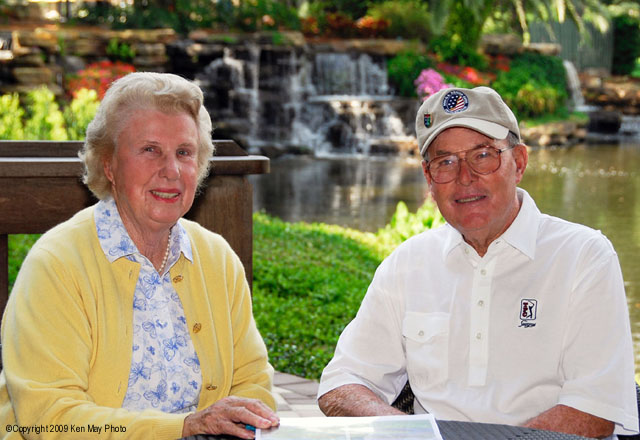
The two world-renowned ASGCA Golf Course Architects, Alice
and Pete Dye, were married in 1950.
I
don't know how this all happened. Deane Beman, then commissioner
of the PGA TOUR called me, and told me they're trying to build
a golf course in Jacksonville. So we came up and we looked at
all this nice, sandy ground around Jacksonville and came around,
and all of a sudden, he said, I think I've got a good deal over
here for some land. I want you to meet this fellow by the name
of Vern Kelly. Mr. Kelly came out, and eventually he became a
pretty good friend.
But
the first time I met Vernon Kelly, president of PGA TOUR Golf
Course Properties, Mr. Kelly kind of took me to this property,
and he had a special way to go around to get into the middle
of this property, and he found the only dry spot on 400 acres,
and he said, look at this tree coverage. I says, "You can't
even see." So Deane got a great deal and he bought the land
for a dollar. I don't know why he ever paid him that (laughter).
But
anyhow, we started out and brought a young superintendent, and
Dave came there. We started digging, and six months later I was
about ready to call Deane and say, Deane, I don't think we're
ever going to get out of here alive, I don't think. But finally
we got her done, and the TPC -- Dave Postlethwait was a
great building superintendent, he ran a bulldozer and track hoe,
he could do everything. He was really a marvelous person.
Then
somehow or another, Dave becomes the greenskeeper, when he's
never cut a blade of grass in his life. So the first year we
got out alive, Jerry Pate won the tournament and of course puts
Deane in the pond. And I of course never thought he was going
to push me, but he did. (laughter)
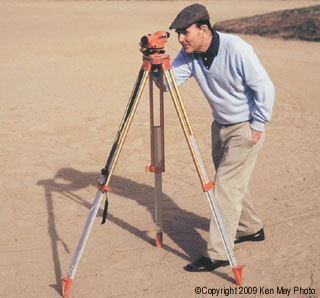 We
got by the first year okay. But the second year they got a new
superintendent, cut the greens a little shorter and started a
bit of a revolution down there. They were ready to kill me. The
second year was really bad. We
got by the first year okay. But the second year they got a new
superintendent, cut the greens a little shorter and started a
bit of a revolution down there. They were ready to kill me. The
second year was really bad.
But
I really appreciate Deane letting me come back, and we went over
the greens and Bobby Weed softened them, and Mr. Finchem let
me come back again a couple years ago, and we went over the Tournament
Players Club one more time, and we're doing, I think, a little
better. People are not quite so mad, and it's draining a little
better and so forth. I really appreciate coming back.
But
the only thing, when I get to thinking, we’ve been back
here five times redoing it. We should have 90 holes but we've
still just got 18.
And
then after the revolution at the tournament players club I sneaked
off to the Dominican Republic, and I went down there to build
a golf course, and I convinced them to build in the country.
You see, they had a big sugar plantation out there, but they
didn't have a paved road within 35 miles, and I kept saying,
well, look, building a golf course, people will eventually get
here somehow or another. So they let me start building a golf
course out there.
One
of the vice presidents came up after I had been there about three
or four months, and he kind of stuttered, he said “Pete,
today I can't speak Spanish or English. We own over 500,000 acres
down here, and you're not even building on our property (laughter).
Well,
the owners down there have been putting up with me since 1970.
I don't know why they haven't shot me, but they haven't. And
if I hold on long enough, I'll build nine more holes. I've got
nine holes under construction down there, and if I do, Mr. Finchem,
they will have 90 holes. They will have 90 holes down there.
Anyhow,
I know that there are three people out here that are trustees
of your organization, and I've been building golf courses for
all of them, including Mr. Evans who now has Oak Tree Golf Club
in Edmund Oklahoma, where I had my first major championship.
It's kind of fallen apart, so we may eventually have to go back
and push a little more dirt out there. And Mr. Kohler is out
there. I've been pushing his stuff around for so long. We're
still speaking, though. Just barely, but we're still speaking.
He's going to have the PGA Championship in '10 and '15 and hopefully
-- I hope I get to see somebody set this up and tell us what
happened in the Ryder Cup in 2020. And then Mr. Goodwin is here
and he's got the Ocean Course where we had the 1991 Ryder Cup
and we're going to have the PGA Championship in 2012. So, how
many people have I forgotten?
Well,
now we’ve also got Mr. Cook, and Mr. Ferguson here. They’ve
bought the old French Lick Resort at West Baden Springs in southern
Indiana. That's where Larry Bird was from, and they've done a
great job, restored the whole area down there, and they've given
me the highest point in Indiana to build a golf course.
And
I know they think I should be done by now, but we're just a little
late and just a little over budget. But I hope to have -- the
PGA has come by and they said, and I hope they're going to have
their club professional championship there in the year 2010.
Also, at French Lick Resort they have the old Donald Ross golf
course that was built back in 1917, which is where Walter Hagen
won the PGA in 1924 and Mickey Wright won the LPGA down there
in 1960.
Well,
a good friend of mine, Lee Schmidt, came in and rebuilt the old
Ross course and left the greens and the mounds just like they
were back in 1917. So now here's an old Ross golf course with
Bermudagrass in the fairways, and the contour from back to front,
and the greens that roll five and six feet. And I have this new
bentgrass golf course up on top of the hill, hopefully that will
have a Stimpmeter reading of 12, which the golfers will play
and then they'll go down and play the one that Mr. Ross built
at six on the Stimpmeter, and on Bermudagrass. And once the club
professionals get wind of that, there will probably be another
revolution.
Thanks a lot. Great to be here. |